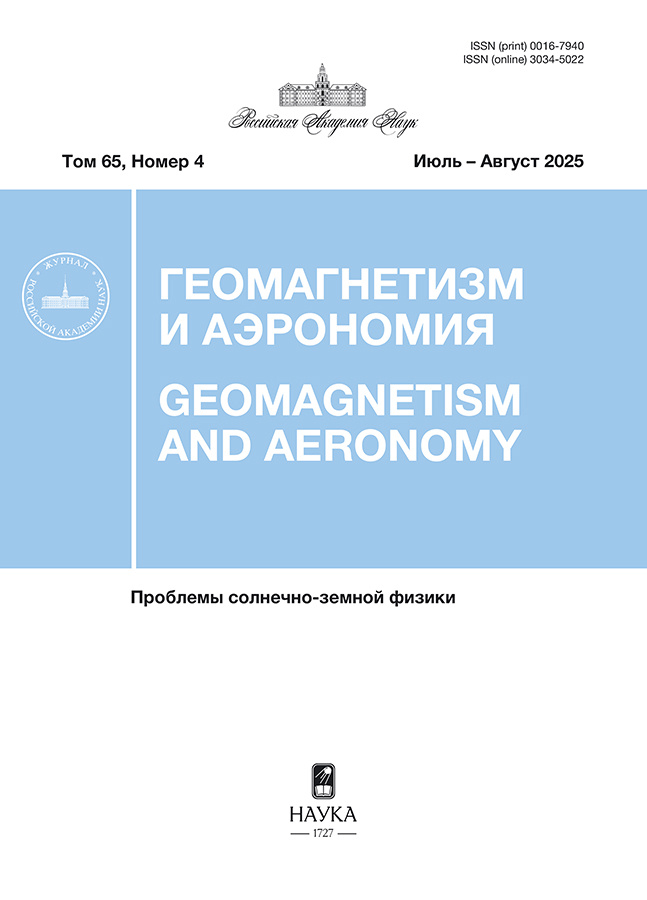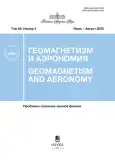Том 65, № 4 (2025)
Статьи
Жгутовые модели солнечных вспышек и переход вспышечного волокна в режим коронального выброса
Аннотация
Описан новый физический механизм вспышечного энерговыделения в бессиловых магнитных жгутах: по мере выхода вершины жгутовой магнитной петли в корону Солнца внешнее давление, удерживающее жгут от бокового расширения, неуклонно падает. При некотором критически низком значении этого давления продольное магнитное поле жгута стремится к нулю на той магнитной поверхности, где токи меняют знак. При этом азимутальный ток и бессиловой параметр начинают неограниченно возрастать, приближаясь к разрыву на этой поверхности. Это приводит к возбуждению плазменной ионно-звуковой неустойчивости в плазме жгута и служит триггером для начала вспышки. Быстрая диссипация энергии токов и магнитного поля на аномальном сопротивлении плазмы индуцирует электрические поля, значительно превышающие поле Дрейсера. В работе обсуждаются силы, действующие в солнечной короне на вспышечное волокно, и условия его перехода в динамический режим коронального выброса массы.
 421-429
421-429


Некоторые особенности эволюции магнитного комплекса активности, включающего активные области NOAA 11944 и NOAA 11946, при его прохождении по диску Солнца
Аннотация
Исследована эволюция свойств магнитного комплекса активности при его прохождении по диску Солнца (03–12).01.2014 г. Магнитный комплекс активности состоит из двух магнитно-связанных через экватор активных областей, расположенных в разных полушариях Солнца: АО NOAA 11944 в Южном полушарии и NOAA 11946 в Северном полушарии. Построены зависимости от времени беззнаковых суммарных магнитных потоков всех пятен, включая поры, и отдельно для каждой полярности для каждой активной области. Сопоставлено изменение суммарного для всех пятен магнитного комплекса активности беззнакового магнитного потока F(t) со временем с изменением суммарной площади соответствующих солнечных пятен S(t). Во всех случаях магнитный поток немонотонно нарастает, достигает максимального значения и затем уменьшается. Обнаружены различия в характере изменения F(t) и S(t) в период (10–12).01.2014 г., которые сопоставляются с характеристиками всплесков излучения в жестком рентгеновском диапазоне и солнечных вспышек в мягком рентгеновском диапазоне. За весь период наблюдений в магнитном комплексе активности не были зарегистрированы корональные выбросы массы типа “гало” и при нахождении магнитного комплекса активности вблизи лимбов было зарегистрировано относительно немного лимбовых корональных выбросов массы.
 430-436
430-436


Отклик жесткости геомагнитного обрезания космических лучей на изменения динамических и магнитных параметров солнечного ветра и геомагнитной активности во время бури 23‒24 марта 2023 г.
Аннотация
Мы исследовали корреляционные связи между жесткостями геомагнитного обрезания космических лучей и параметрами межпланетного пространства, солнечного ветра и геомагнитной активности во время сильной магнитной бури 23–24 марта 2023 г. Жесткости геомагнитного обрезания вычислялись с помощью расчета траекторий частиц в магнитном поле магнитосферы по модели Цыганенко Ts01. Анализ показал, что вариации жесткости обрезания контролируются в основном изменениями индекса геомагнитной активности Dst (коэффициент корреляции k ≈ 0.95), а также электромагнитными параметрами, такими как полное значение межпланетного магнитного поля B, его компонента Bz, азимутальная компонента электрического поля Ey и параметр плазмы β (│k│≈ 0.6–0.75). В то же время параметры солнечного ветра ‒ скорость V, плотность N и динамическое давление P, мало влияют на изменения жесткости геомагнитного обрезания (│k│ <0.45).
 437-447
437-447


Временная последовательность квазипериодических геомагнитных возмущений во время суббурь
Аннотация
По данным двумерной сети магнетометров IMAGE и магнитных станций, расположенных на территории России, проведено исследование последовательности квазипериодических геомагнитных вариаций с амплитудой до 600 нТл и длительностью ~20 мин, возникших в послеполуночном секторе в период небольшой мировой магнитной бури. Показано, что геомагнитные вариации возникали на фоне суббурь на одной и той же исправленной геомагнитной широте Φ′ ~ 65° последовательно одна за другой и перемещались на ~20° по долготе на восток, причем новая вариация возникала, когда предыдущая переместилась на ~10°. Показано, что ионосферный источник этих вариаций – пара холловских токовых вихрей, каждый из которых имеет эллиптическую форму с большей осью в направлении север–юг. Оценка размеров ионосферного источника составляет ~940 км в направлении запад–восток (каждый холловский токовый вихрь ~470 км) и ~1000 км в направлении север–юг. Центры ионосферных источников этих вариаций перемещались в восточном направлении со скоростью ~0.8 км/с. Показано, что каждая геомагнитная вариация сопровождается всплеском геомагнитных пульсаций Pi1–2. Сделано предположение, что наблюдаемые геомагнитные вариации создаются магнитными полями ионосферных токовых систем микросуббурь.
 448-458
448-458


Изменения со временем связи между индексами солнечной активности
Аннотация
Представлены результаты анализа долговременных изменений связи между индексами солнечной активности за 1957–2022 гг. Для этого использованы сглаженные (с помощью 24-месячного фильтра) индексы F10, F30, Ly-α, MgII, Ri и IG – поток радиоизлучения Солнца на длинах волн 10.7 и 30 см, солнечное излучение в линии Лайман-альфа водорода (121.567 нм), отношение центральной части к флангам в полосе излучения магния 276–284 нм на Солнце, международное число солнечных пятен и ионосферный индекс, который определен по ионосферным данным как аналог числа солнечных пятен. Подтверждено, что весь период измерений можно разделить на интервалы 1957–1980, 1981–2012 и 2013–2022 гг., в которых связи между индексами солнечной активности отчетливо различаются. В интервале 1957–1980 гг. эти связи стабильны по времени, т.е. линейный по времени тренд в зависимости одного индекса солнечной активности от другого практически отсутствует. В интервале 2013–2022 гг. такие тренды обычно значимы. В этом интервале тренд ∆IG(X) = IG – IG(X) отрицателен и значим для X = F10, F30, MgII, Ly-α или Ri , где IG(X) – средняя для данного интервала зависимость IG от X.
 459-466
459-466


Влияние вариаций солнечной активности на межсуточную изменчивость NmE по данным наземных ионозондов низких широт в геомагнито-спокойных условиях
Аннотация
Выполнено исследование суточных вариаций статистических характеристик относительной межсуточной изменчивости электронной концентрации NmE максимума слоя E ионосферы для каждого месяца М года в геомагнито-спокойных условиях при низкой и умеренной солнечной активности по данным часовых измерений критической частоты слоя E ионосферы за периоды 1957−1989 и 1998−2006 гг. по данным ионозондов Huancayo и Jicamarca соответственно. В работе вычислялись математическое ожидание NmEE(UT,M), арифметически среднее NmEA(UT,M), стандартное отклонение σE (UT,M) и коэффициент вариаций CVE(UT,M) величины NmE(UT,M) от NmEE(UT,M) соответственно, где UT – мировое время. Расчеты показали, что величина CVE(UT,M), определяющая относительную межсуточную изменчивость NmE составляет 4–14 и 3–18% для условий низкой и умеренной солнечной активности соответственно. Впервые показано, что при изменении солнечной активности от низкого до умеренного уровня межсуточная изменчивость NmE может как увеличиться, так и уменьшиться. В первом случае увеличение σE(UT,M) преобладает над ростом NmEE(UT,M), во втором – рост NmEE(UT,M) преобладает над увеличением σE(UT,M).
 467-481
467-481


Тренды параметров слоя F2 по данным ст. Свердловск (Арти, 56 N)
Аннотация
Рассматриваются долговременные вариации (тренды) двух параметров ионосферного слоя F2 (foF2 и hmF2) по наблюдениям на ионосферной станции Sverdlovsk (Arti) и вычисленных величин ТЕС над указанной станцией. Рассматриваются пять околополуденных моментов местного времени. Основной анализ проводится для трех зимних месяцев, однако для сравнения приводятся также величины трендов foF2 и hmF2 для весеннего месяца апреля, летнего месяца июля и осеннего месяца октября. Получено подтверждение наличия сезонных вариаций трендов foF2: отрицательные тренды сильнее всего зимой. Полученные результаты согласуются с результатами, полученными ранее для среднеширотных станций Северного полушария. Для трендов hmF2 не обнаружено заметных сезонных вариаций. Рассматриваются также тренды величин ТЕС над указанной станцией. Показано, что наблюдается приемлемое согласие относительных (в процентах) трендов foF2 и ТЕС.
 482-499
482-499


Изменение критической частоты foF2 со временем и его интерпретация
Аннотация
Рассматривается результат недавней публикации Qiann and Mursula, в которой показан рост со временем отношения смоделированных и наблюдаемых величин плотности термосферы на спутниковых высотах. Высказано предположение, что этот рост связан с наличием отрицательного тренда плотности, который не описывается полностью моделью. Для подтверждения этой концепции рассмотрено изменение со временем отношения смоделированных и наблюдаемых величин критической частоты слоя F2, foF2(мод)/foF2(наб), по зимним наблюдениям на станциях Северного и Южного полушарий. Показано, что для этого отношения наблюдается такой же рост, как и для отношения плотностей. Найдено, что скорость этого роста foF2 хорошо коррелирует с трендами foF2 (в МГц/год) в зимние месяцы, когда максимальны отрицательные тренды. В летние месяцы, когда тренды foF2 малы, рост отношения foF2(мод)/foF2(наб) практически отсутствует. Эти обстоятельства и позволяют предполагать, что результаты Qiann and Mursula показывают, что модель не описывает полностью отрицательные тренды плотности.
 500-512
500-512


Различия месячных медиан foF2 внутри сезонов в среднеширотной ионосфере в период низкой солнечной активности 2007–2008 гг.
Аннотация
Выполнен сопоставительный анализ месячных медиан суточных вариаций критической частоты регулярного F2-слоя ионосферы (foF2) для всех “стандартных” сезонов в период низкой солнечной активности 2007–2008 гг. Анализируются часовые данные ручной обработки измерений, проведенных на среднеширотных наземных станциях вертикального зондирования ионосферы Wakkanai (Япония) и расположенной почти симметрично относительно географического экватора Hobart (Австралия). Обнаружено, что относительные различия медианы третьего месяца любого из “стандартных” сезонов по сравнению с медианой второго месяца сезона существенно выше, чем различия медианы первого месяца сезона относительно медианы второго месяца сезона. Показано также на конкретном примере этих двух среднеширотных станций, что по своим характеристикам медиана ноября (последнего месяца осеннего сезона) соответствует началу зимнего сезона, а медиана мая (последнего месяца весеннего сезона) – началу летнего сезона. Установлено, что относительный вклад солнечного излучения в изменения величины электронной концентрации в максимуме области F (NmF2) в условиях низкой солнечной активности в равноденственные сезоны, связанный с вариациями величины и скорости изменения зенитного угла Солнца, не меньше половины того относительного вклада в изменения NmF2, который вносят вариации состава нейтральной атмосферы.
 513-526
513-526


Аэрозольный слой нижней термосферы: III. Наблюдение в отсутствие Луны при больших зенитных углах Солнца
Аннотация
Приведены результаты космического эксперимента “Терминатор” на Международной космической станции (МКС), полученные в видимом и ближнем ИК-диапазонах спектра при лимбовой геометрии съемки атмосферы Земли в отсутствии на небосводе Луны и при больших зенитных углах Солнца (>145°). В результате обработки полученных данных сделан вывод, что предыдущая версия механизма свечения данной слоистой атмосферной структуры (САС) является неверной, так как рассеяние солнечного света на аэрозольных частицах метеорного происхождения не может объяснить свечение слоистой атмосферной структуры при больших зенитных углах Солнца (>145°). В настоящей статье предлагается свечение наблюдаемой слоистой атмосферной структуры рассматривать как тепловое излучение потока метеорных частиц, входящих в атмосферу. Соответственно, наблюдаемую светящуюся слоистую атмосферную структуру интерпретировать как слой атмосферы (80–100 км), в котором пролетающие сквозь него расплавленные метеорные частицы, разогретые до температуры 2000–3000 градусов, излучают с максимальной интенсивностью.
 527-537
527-537


Изменение климата Земли в 13–15 тысячелетиях до нашей эры. Возможная причина
Аннотация
Данные по содержанию космогенного изотопа 14С в земной атмосфере позволяют, как известно, изучать вариации солнечной активности в прошлые эпохи. Однако изменения во времени земного климата приводят также к искажению информации о солнечной активности. В данной работе рассматривается временной интервал с конца 17-го до начала 10-го тысячелетия до нашей эры. На этот время, как известно, приходилось несколько периодов изменения климата Земли. Наблюдалось несколько потеплений (Майендорфское, Аллерёдское) и похолоданий (Древнейший, Древний и Поздний Дриасы). Причины этих изменений до сих пор не установлены. Показано, что возможной причиной похолодания во время Древнейшего Дриаса могло быть понижение активности Солнца.
 538-541
538-541


Квазидвухсотлетняя вариация в температуре Северного полушария Земли
Аннотация
Восемь реконструкций температуры Северного полушария Земли, охватывающих временные интервалы длительностью 1192–2016 лет, были проанализированы с использованием Фурье и вейвлетного анализа и метода главных компонент. Обнаружена цикличность полушарного масштаба с периодом 170–250 лет, проявляющаяся на протяжении более 1000 последних лет. Показано, что эта вариация может иметь определенный вклад в потепление в первой половине XX в. Однако последние 4–5 десятилетий, скорее всего, являются периодом спада этого цикла. Хотя период обнаруженной вариации близок к периоду солнечного цикла Зюсса, связи между температурной и солнечной цикличностями не удалось обнаружить. Обсуждаются возможные источники выявленной двухсотлетней периодичности.
 542-551
542-551


Изотопная и солярная геохронология и климатостратиграфия неоплейстоцена Северной Евразии
Аннотация
Показана возможность объяснения причин глобальных климатических изменений в неоплейстоцене Северной Евразии на основе астрономической теории изменений климата.
В неоплейстоцене обнаружен эффект разделения сезонной интенсивности облучения по фазам интенсивности годового облучения Земли, которым объясняется механизм проявления 100-тысячелетнего цикла в природной системе Земли. Выполнена солярная настройка (моделирование) климатических эпох неоплейстоцена Северной Евразии. На основе модели определены солярные условия и механизм развития покровных оледенений в Северной Евразии в неоплейстоцене. Причина глобальных климатических изменений связана с динамикой радиационного фактора, репрезентативными характеристиками которого являются интенсивность летнего облучения и интенсивность зимнего меридионального переноса радиационного тепла в Северном полушарии. Хронологические расхождения модельных и фактических климатических эпох, отражающие нелинейный отклик природной системы на динамику облучения, в среднем составляют около 7 тысяч лет. Отмечается слабый отклик изотопно-кислородного состава (δ18О) донных фораминифер (максимальный размах колебаний 0.2%) на колебания радиационных факторов глобальных климатических изменений в Северной Евразии: интенсивности летнего облучения в фазовом разделении сезонного облучения (средний размах для летнего полугодия 0.486%, для июля – 0.785%) и в фазах климатической прецессии (средний размах 4.336%).
 552-563
552-563


НЕКРОЛОГ
Лещенко Владимир Сергеевич (15.01.1940 ‒ 16.06.2025)
 564-565
564-565


Мохов Игорь Иванович 20.07.1950‒24.06.2025
 566-566
566-566










